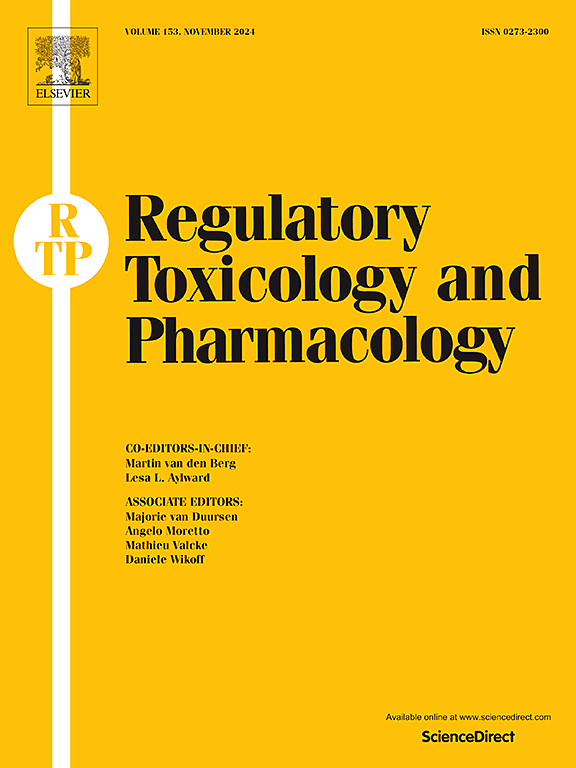Updated assessment of the genotoxic potential of titanium dioxide based on reviews of in vitro comet, mode of action and cellular uptake studies, and recent publications
IF 3
4区 医学
Q1 MEDICINE, LEGAL
引用次数: 0
Abstract
In 2021 the European Food Safety Authority (EFSA) concluded that “A concern for genotoxicity of TiO2 particles that may be present in E 171 could therefore not be ruled out.”. A detailed review of the genotoxicity of titanium dioxide (TiO2) was subsequently published by Kirkland et al. (2022) using a comprehensive weight of evidence (WoE) approach in which test systems and endpoints were allocated different levels of relevance. At that time only 34 publications met the reliability and quality criteria for being most relevant in the evaluation of genotoxicity, and based on these it was concluded that the existing evidence did not support a direct DNA damaging mechanism for TiO2. Recently a number of regulatory opinions have been published, in which papers were cited that described in vitro DNA damage (mainly comet), mode of action, and cellular uptake studies that were not discussed in Kirkland et al. (2022). Furthermore, a number of additional papers have been published recently or have been identified from the regulatory opinions as a result of using extended search criteria. A total of 70 publications not previously reviewed in Kirkland et al. (2022) have been reviewed here, and again show that the published data on the genotoxicity of TiO2 are inconsistent, often of poor quality, and in some cases difficult to interpret. The cellular uptake studies show some evidence of cytoplasmic uptake, particularly in cells treated in vitro, but there is no convincing evidence of nuclear uptake. In terms of genotoxicity, the conclusions of Kirkland et al. (2022) that existing evidence does not support a direct DNA damaging mechanism for titanium dioxide (including nano forms), and that the main mechanism leading to TiO2 genotoxicity is most likely indirect damage to DNA through generation of reactive oxygen species (ROS), are still valid.
根据对体外彗星、作用模式和细胞吸收研究的审查以及最近的出版物,对二氧化钛的遗传毒性潜力进行最新评估。
2021 年,欧洲食品安全局(EFSA)得出结论:"因此不能排除 E 171 中可能存在的二氧化钛微粒的遗传毒性问题"。随后,Kirkland 等人(2022 年)采用综合证据权重法(WoE),对二氧化钛(TiO2)的基因毒性进行了详细审查。当时,只有 34 篇出版物符合与遗传毒性评估最相关的可靠性和质量标准,并据此得出结论,现有证据并不支持二氧化钛的直接 DNA 损伤机制。最近发表了一些监管意见,其中引用的论文描述了 Kirkland 等人(2022 年)未讨论的体外 DNA 损伤(主要是彗星)、作用模式和细胞吸收研究。此外,最近还发表了一些其他论文,或通过使用扩展搜索标准从监管意见中发现了一些其他论文。本文共审查了 70 篇未在 Kirkland 等人(2022 年)中审查过的论文,这些论文再次表明,已发表的有关二氧化钛遗传毒性的数据并不一致,通常质量较差,在某些情况下难以解释。细胞摄取研究显示了一些细胞质摄取的证据,特别是在体外处理的细胞中,但没有令人信服的核摄取证据。就遗传毒性而言,Kirkland 等人(2022 年)的结论仍然有效,即现有证据不支持二氧化钛(包括纳米形式)的直接 DNA 损伤机制,导致二氧化钛遗传毒性的主要机制很可能是通过产生活性氧 (ROS) 间接损伤 DNA。
本文章由计算机程序翻译,如有差异,请以英文原文为准。
求助全文
约1分钟内获得全文
求助全文
来源期刊
CiteScore
6.70
自引率
8.80%
发文量
147
审稿时长
58 days
期刊介绍:
Regulatory Toxicology and Pharmacology publishes peer reviewed articles that involve the generation, evaluation, and interpretation of experimental animal and human data that are of direct importance and relevance for regulatory authorities with respect to toxicological and pharmacological regulations in society. All peer-reviewed articles that are published should be devoted to improve the protection of human health and environment. Reviews and discussions are welcomed that address legal and/or regulatory decisions with respect to risk assessment and management of toxicological and pharmacological compounds on a scientific basis. It addresses an international readership of scientists, risk assessors and managers, and other professionals active in the field of human and environmental health.
Types of peer-reviewed articles published:
-Original research articles of relevance for regulatory aspects covering aspects including, but not limited to:
1.Factors influencing human sensitivity
2.Exposure science related to risk assessment
3.Alternative toxicological test methods
4.Frameworks for evaluation and integration of data in regulatory evaluations
5.Harmonization across regulatory agencies
6.Read-across methods and evaluations
-Contemporary Reviews on policy related Research issues
-Letters to the Editor
-Guest Editorials (by Invitation)

 求助内容:
求助内容: 应助结果提醒方式:
应助结果提醒方式:


